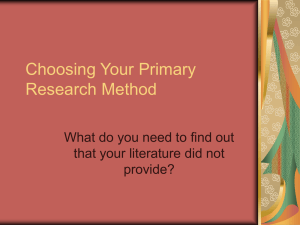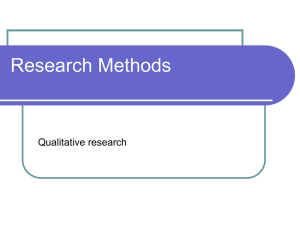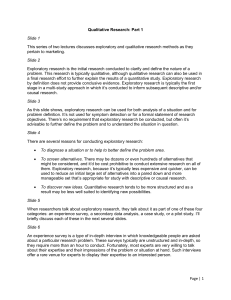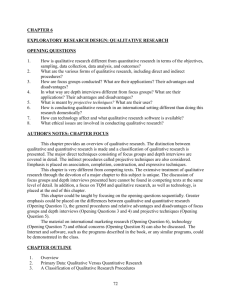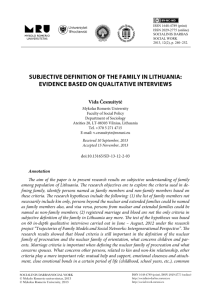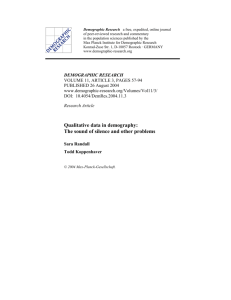Chapter 1: Overview of Methods
advertisement
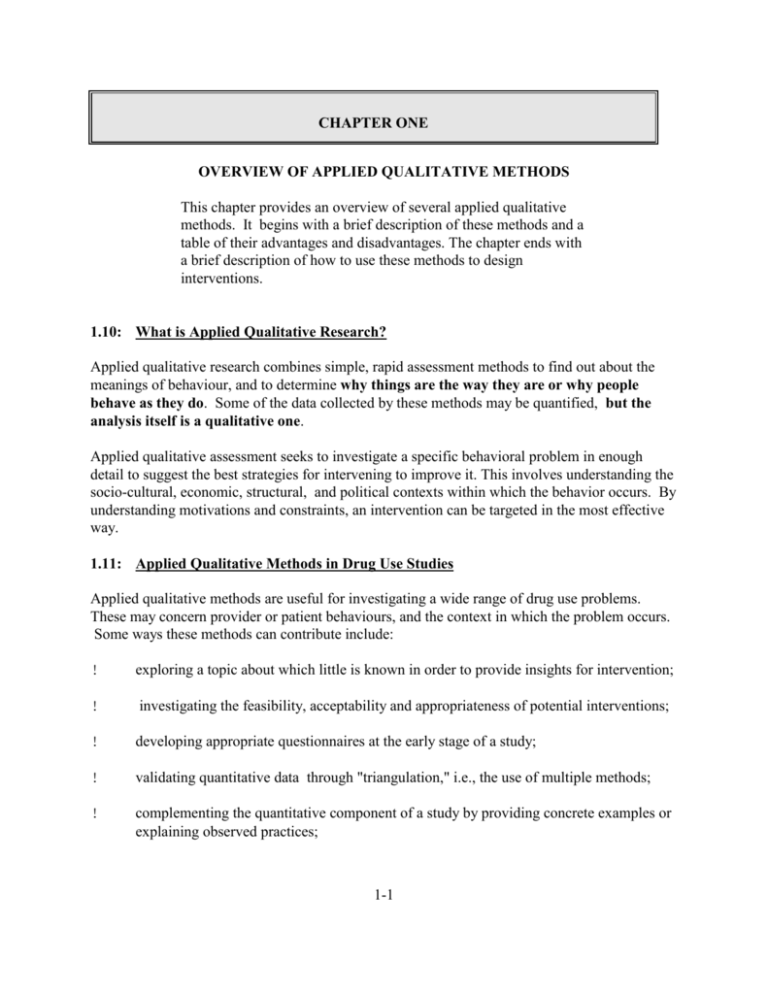
CHAPTER ONE OVERVIEW OF APPLIED QUALITATIVE METHODS This chapter provides an overview of several applied qualitative methods. It begins with a brief description of these methods and a table of their advantages and disadvantages. The chapter ends with a brief description of how to use these methods to design interventions. 1.10: What is Applied Qualitative Research? Applied qualitative research combines simple, rapid assessment methods to find out about the meanings of behaviour, and to determine why things are the way they are or why people behave as they do. Some of the data collected by these methods may be quantified, but the analysis itself is a qualitative one. Applied qualitative assessment seeks to investigate a specific behavioral problem in enough detail to suggest the best strategies for intervening to improve it. This involves understanding the socio-cultural, economic, structural, and political contexts within which the behavior occurs. By understanding motivations and constraints, an intervention can be targeted in the most effective way. 1.11: Applied Qualitative Methods in Drug Use Studies Applied qualitative methods are useful for investigating a wide range of drug use problems. These may concern provider or patient behaviours, and the context in which the problem occurs. Some ways these methods can contribute include: ! exploring a topic about which little is known in order to provide insights for intervention; ! investigating the feasibility, acceptability and appropriateness of potential interventions; ! developing appropriate questionnaires at the early stage of a study; ! validating quantitative data through "triangulation," i.e., the use of multiple methods; ! complementing the quantitative component of a study by providing concrete examples or explaining observed practices; 1-1 ! ! developing appropriate materials for educational interventions; identifying problems in ongoing interventions and suggesting appropriate solutions; ! assessing the impact of on-going or completed interventions. Although applied qualitative methods can be used in all these ways, this manual will focus on how they might contribute to designing the strongest possible interventions. 1.12: Summary of Advantages and Disadvantages This manual describes four methods that have been particularly useful for understanding drug use problems: in-depth interviews, focus group discussions, structured observations and structured questionnaires. The following table briefly summarizes each of these methods and their advantages and disadvantages. Table 1.1: Summary of Main Features of Suggested Field Methods Method Advantages Disadvantages In-Depth Interview Open-ended face to face interactions, in which an interviewer tries to elicit a respondent=s knowledge, opinions, feelings, or behavior related to a defined set of topics with no predetermined list of responses Flexible and allows interviewer more opportunity to ask questions Permits observation of non-verbal expressions of respondents Can be difficult to find good interviewers Personal opinion of interviewer may creep into interview Personal contact with respondent enhances good probing Difficult to generalize results Quicker and cheaper than individual interviews involving the same number of people Depth of information may be limited since it is hard to probe individual ideas Greater pool of expertise is tapped than in individual interviews Group consensus may inhibit original, unorthodox, or minority views Focus Group Discussion Open-ended discussions facilitated by a trained moderator with a small homogeneous group (6-12) of respondents on a defined list of topics Better way than individual interviewing to explore sensitive subjects in some cultures A few people may dominate the discussion Provides an excellent means of obtaining information from Success of a group discussion can be unpredictable 1-2 Method Advantages Disadvantages illiterate communities Structured Observation Systematic recording of data about a set of events or interactions using a predetermined format It enables behavior to be recorded in context Presence of observer can affect the subjects' behavior and thereby bias the data It affords an opportunity to understand situational factors that influence behavior Observer's bias in recording can affect the information obtained It is very helpful in validating data obtained by other methods A structured format may limit the type of information collected It verifies what people do compared to what they say they do Structured Questionnaire Structured instrument containing open- &/or closeend questions used with a relatively large sample of respondents to examine knowledge, attitude, or reported practices. Samples are relatively large, so results may be more generalizable Respondents have little control over the interview process Data easily quantified and analyzed Little flexibility to collect data on aspects of the problem not covered in questionnaire Findings can be compared with those of similar studies Structural rigidity may sometimes influence responses Can validate data from interviews, focus groups, or observations 1.13: Choosing the Right Method(s) Although the applied qualitative methods in this manual can be used to examine all the underlying reasons of attitudes, behaviors and practice, each has its particular strengths and weaknesses. Some methods may be better suited for certain situations or problems, for example: a. In-Depth Interview is a suitable choice where: ! group interaction and peer pressure are likely to inhibit individual responses and make discussion unproductive; ! in certain cultures, when the topic is so sensitive that respondents would be 1-3 unwilling to talk openly in a group; 1-4 b. c. d. ! it is necessary to know and understand how attitudes and behaviors link together on an individual basis; ! respondents are geographically dispersed or cannot be assembled. Focus Group Discussion is a suitable choice if: ! social network influences are strong and may influence the behavior of interest; ! group interaction is highly desired and favored to stimulate a useful discussion; ! the topic is not so embarrassing as to prompt respondents to withhold information ! a single subject area is being examined, and differences of behavior are less relevant; ! an acceptable number of target respondents can be reasonably assembled at a given location. Structured Observation method is a suitable choice if: ! the aim is to examine a behavior in its natural setting; ! to see if what people actually do confirms or contradicts what they say they do; ! collecting information on non-verbal aspects of behavior is highly desired; ! validating data obtained with other methods. Structured Questionnaires are most appropriate where: ! when the questions of interest are already well known, and the objective is to examine knowledge, attitudes, or practices in a defined population; ! information is needed from a relatively larger sample in order to generalize results from other methods; ! there is a need to follow up a preliminary enquiry to enrich results. Although each method has specific strengths, an approach using a number of different methods in complementary fashion may be the most comprehensive and effective way to study a problem. 1-5

